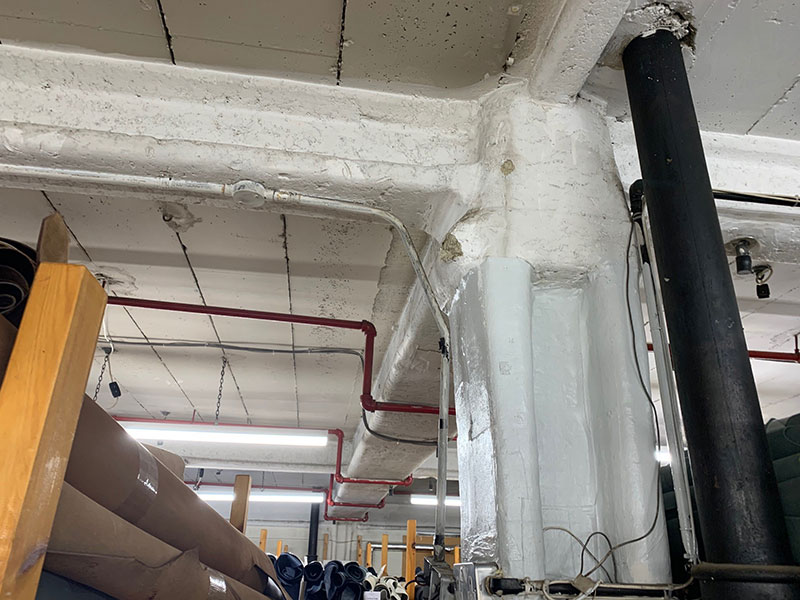Landmark report into asbestos in UK buildings highlights persistent dangers of the substance
The report in question was published in response to the Work and Pensions Committee’s recent inquiry into the management of asbestos in the UK. That inquiry looked at the approach the Health and Safety Executive (HSE) took to managing asbestos, and drew attention to the lack of evidence with regard to the extent and condition of asbestos in the country’s public buildings.
So, what did the report reveal about the situation of asbestos within the UK’s property portfolio, and the perils to human health that the substance might still present?
The background of the report
The ATaC and NORAC report, entitled Review of UK asbestos management 2022, and subtitled as “the first annual data analysis report into asbestos in UK buildings”, was published in November 2022.
The report analyses anonymised data that a number of United Kingdom Accreditation Service (UKAS) accredited asbestos survey organisations gathered over the six months from October 2021 to March 2022. It marks the first time that any organisation has attempted to analyse and understand the considerable body of data that is already gathered in relation to asbestos in UK buildings.
It is now more than 20 years since the HSE introduced the “Duty to Manage” asbestos, with the implementation of the Control of Asbestos at Work Regulations 2002.
In early 2022, the Department for Work and Pensions (DWP) finished its committee inquiry into how HSE managed asbestos in the UK. It became apparent during this inquiry that there was little evidence specifically relating to the present extent and condition of asbestos in buildings around the UK. That might seem a surprising situation to some, given how crucial these aspects are for assessing how effectively the dangerous and now-banned material is being managed nationwide.
The good news, however, is that a large proportion of asbestos surveys today are undertaken with the use of electronic data collection and report generation. This helps make it a relatively straightforward process to collate much of the empirical data on which analysis like that outlined in the ATaC and NORAC report depends.
After an initial request for information, a number of Inspection Bodies (IBs) came to an agreement to collate their survey information into a single data set. According to the ATaC and NORAC report, a total of 20 companies participated in this exercise.
The report findings
As aforementioned, the report consists of an analysis of already-existent data, collected over a period of six months from October 2021 to March 2022. The key findings include the following:
How much asbestos material was found in public buildings?
Across the six months to which this report relates, inspections were carried out at a total of 128,761 sites. The inspections were undertaken for various purposes, with some of them taking the form of management surveys, refurbishment surveys, and demolition surveys. Some of the inspections were effectively re-inspections of materials that were identified as containing, or presumed to contain, asbestos.
Across the 128,761 sites, there are 1,016,783 records in all. Those records encompass negative samples, as well as positive asbestos items and presumptions made in accordance with the HSG264 method. Of the 1,016,783 records, 710,433 items were designated as being positive asbestos, whether by presumption or analysis.
Of the 128,761 inspected sites, it was found that asbestos-containing materials (ACMs) were present on 100,660 of them. This works out as 78% of the inspected premises having asbestos on-site, which broadly corresponds with the number of schools where asbestos is estimated to be present.
Of that, how much was deemed to be damaged material?
The question of what condition asbestos is in, is crucial as far as the assessment of safety is concerned. While asbestos materials that are in good condition and are not disturbed or damaged are not believed to pose a risk to health, when asbestos containing materials are in poor condition or are disturbed or damaged, asbestos fibres can be released into the air. This, in turn, can lead to the fibres being inhaled or ingested by anyone nearby, which could eventually lead to the development of serious disease.
It is greatly useful, then, that the analysed data in the ATaC and NORAC report also includes information on the condition of asbestos containing materials. Only asbestos containing materials that are in a “good” condition are not believed to pose a risk to occupiers’ health, and of the 710,433 asbestos items, only 202,821 – 29% – were deemed to be in “good” condition.
This meant that the remaining 507,612 items (71%) were recorded as having been “damaged” to some degree, whether this was low, medium, or high damage. This works out as 63% of all the visited sites, or 81,667 premises.
According to the analysis, 48,583 of the asbestos containing materials – 7% – were recorded as having either medium or high damage, which means that these particular items are likely to pose the greatest risk to occupiers of the affected buildings.
Asbestos in domestic properties
When assessing asbestos-containing materials, there is an important distinction to be made between “licensed” and “non-licensed” materials.
“Licensed” products are those that are likely to require removal by a licensed asbestos contractor due to the relatively higher risk they are believed to present, with common examples including asbestos insulating board (AIB), thermal insulation, and sprayed coatings.
Asbestos materials that are classified as “non-licensed”, meanwhile, are those where a licence isn’t required in order to remove them – although training is still needed – because they are believed to pose a lower risk.
Of the total tally of 128,761 sites for which information was provided and analysed for the report, domestic premises made up 94,116 sites, representing 73% of the total. Of those, 86% – or 80,731 sites – contained asbestos-containing materials to some degree. A total of 389,700 asbestos items were recorded across those 80,731 premises, equating to almost five occurrences of asbestos-containing materials for each property.
Around 16% of domestic properties were found to contain licensed asbestos materials, with nearly 44% of the occurrences showing evidence of damage. Across the domestic premises, 29,778 of the ACM items were classified as licensed, while 359,922 were classified as non-licensed.
Reinspection of asbestos-containing materials
It was also found through analysis of the data that 280,453 items had been subject to re-inspection. Of the reinspected items, around 32% were licensable ACM, and of those, three-quarters (75%) were damaged to some extent. This meant that only 25% were recorded as being in good condition. Nearly 9% of the items were given the highest possible damage score.
The recommendations from the report
With the collated data, as detailed in the report, has provided a crucial snapshot of asbestos materials in UK buildings within a particular bracket of time, the authors said that some minor changes might allow for even greater insight to be gained from it. This, in turn, could allow for improved regulation and guidance to be developed.
The standardisation of data collection and terminology for any national database
The ATaC and NORAC report said that the process of reviewing the data had led to the identification of a “wide range of definitions and terminology that is present not only between organisations but also within organisations.”
The text continued: “Considerable effort has been expended in rationalising the data for this exercise and the same would be necessary if any national database was to be developed.
“The authors of this report suggest that before any work is undertaken to develop a national asbestos database, an effort is made to standardise the data collection and reporting terminology between the existing database systems.”
In his response to the ATaC and NORAC report, Stephen Timms MP – Chair of the Work and Pensions Select Committee – said the data could provide a good basis for such a national asbestos database, an idea also suggested by the Committee’s own report earlier in 2022.
A national asbestos database would theoretically provide a comprehensive analysis of the scale of the asbestos problem across all the UK’s public buildings; however, such an idea has been rejected by the UK Government.
Property type data
The authors of the report said it had also become apparent through the data that there were differences in how types of properties were recorded. They said that this was “most clearly shown in the differences in domestic and communal area collection methodologies.”
The report said that the data did not allow for the segmentation of properties by type or function. This led the authors to suggest that “all accredited Inspection Bodies and software providers consider the expansion and clear definition of the property types listed” to include such examples as schools, retail premises, industrial premises, healthcare premises, infrastructure, and communal areas of all domestic properties.
The authors continued: “We would also suggest that asbestos removal work is identified in these sectors to determine where efforts are being made to mitigate future asbestos risks.”
Expanding the report dataset
The report also noted that there was a lack of available historical data in relation to the extent of the asbestos legacy the UK faced. The authors said they were in discussions with the participating organisations to ensure this same data is provided every year.
Finally, it was suggested by the authors that it would be beneficial to broaden the dataset through the participation of a greater number of companies when the exercise came to be repeated.
Contact Oracle Solutions today for help fulfilling your own asbestos management obligations
There is no doubt about it; the full report from ATaC and NORAC sets out a stark picture of the troubling asbestos legacy that continues to confront the UK, including the high proportion of asbestos materials that remain in the country’s public buildings.
Here at Oracle Solutions, we stand ready to assist all manner of commercial clients with their efforts to manage asbestos on their sites responsibly. To learn more and to request your free asbestos quote, please contact us today via phone or email.

Written by Jess Scott
Jess Scott has been an all-round asbestos consultant since 1996. That’s nearly 3 decades of asbestos knowledge. He spends his time sharing that knowledge with the team at Oracle and with their clients. Jess's goal is, and always has been, to use my expertise in helping people to comply with the law. This legal compliance ultimately helps to protect everyone from the harmful effects of asbestos. Jess has acted as an asbestos expert witness in legal cases and is involved in many asbestos educational activities throughout the UK.


